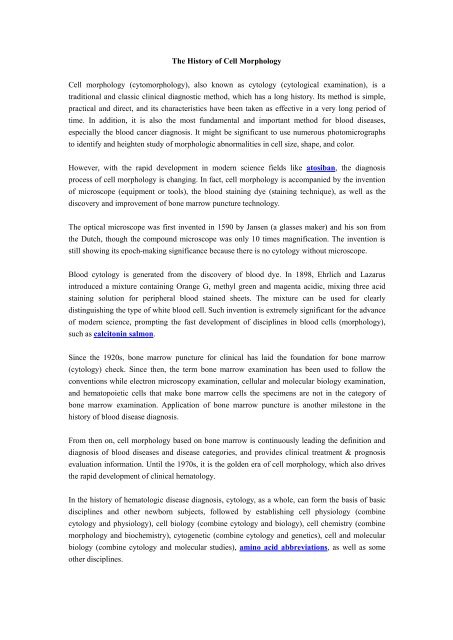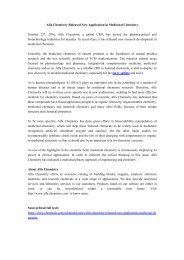The History of Cell Morphology
The History of Cell Morphology: http://www.creative-peptides.com/product/calcitonin-salmon-item-10-101-08-23.html.
The History of Cell Morphology: http://www.creative-peptides.com/product/calcitonin-salmon-item-10-101-08-23.html.
Create successful ePaper yourself
Turn your PDF publications into a flip-book with our unique Google optimized e-Paper software.
<strong>The</strong> <strong>History</strong> <strong>of</strong> <strong>Cell</strong> <strong>Morphology</strong><br />
<strong>Cell</strong> morphology (cytomorphology), also known as cytology (cytological examination), is a<br />
traditional and classic clinical diagnostic method, which has a long history. Its method is simple,<br />
practical and direct, and its characteristics have been taken as effective in a very long period <strong>of</strong><br />
time. In addition, it is also the most fundamental and important method for blood diseases,<br />
especially the blood cancer diagnosis. It might be significant to use numerous photomicrographs<br />
to identify and heighten study <strong>of</strong> morphologic abnormalities in cell size, shape, and color.<br />
However, with the rapid development in modern science fields like atosiban, the diagnosis<br />
process <strong>of</strong> cell morphology is changing. In fact, cell morphology is accompanied by the invention<br />
<strong>of</strong> microscope (equipment or tools), the blood staining dye (staining technique), as well as the<br />
discovery and improvement <strong>of</strong> bone marrow puncture technology.<br />
<strong>The</strong> optical microscope was first invented in 1590 by Jansen (a glasses maker) and his son from<br />
the Dutch, though the compound microscope was only 10 times magnification. <strong>The</strong> invention is<br />
still showing its epoch-making significance because there is no cytology without microscope.<br />
Blood cytology is generated from the discovery <strong>of</strong> blood dye. In 1898, Ehrlich and Lazarus<br />
introduced a mixture containing Orange G, methyl green and magenta acidic, mixing three acid<br />
staining solution for peripheral blood stained sheets. <strong>The</strong> mixture can be used for clearly<br />
distinguishing the type <strong>of</strong> white blood cell. Such invention is extremely significant for the advance<br />
<strong>of</strong> modern science, prompting the fast development <strong>of</strong> disciplines in blood cells (morphology),<br />
such as calcitonin salmon.<br />
Since the 1920s, bone marrow puncture for clinical has laid the foundation for bone marrow<br />
(cytology) check. Since then, the term bone marrow examination has been used to follow the<br />
conventions while electron microscopy examination, cellular and molecular biology examination,<br />
and hematopoietic cells that make bone marrow cells the specimens are not in the category <strong>of</strong><br />
bone marrow examination. Application <strong>of</strong> bone marrow puncture is another milestone in the<br />
history <strong>of</strong> blood disease diagnosis.<br />
From then on, cell morphology based on bone marrow is continuously leading the definition and<br />
diagnosis <strong>of</strong> blood diseases and disease categories, and provides clinical treatment & prognosis<br />
evaluation information. Until the 1970s, it is the golden era <strong>of</strong> cell morphology, which also drives<br />
the rapid development <strong>of</strong> clinical hematology.<br />
In the history <strong>of</strong> hematologic disease diagnosis, cytology, as a whole, can form the basis <strong>of</strong> basic<br />
disciplines and other newborn subjects, followed by establishing cell physiology (combine<br />
cytology and physiology), cell biology (combine cytology and biology), cell chemistry (combine<br />
morphology and biochemistry), cytogenetic (combine cytology and genetics), cell and molecular<br />
biology (combine cytology and molecular studies), amino acid abbreviations, as well as some<br />
other disciplines.
In the 1970s and 1980s, cytogenetic techniques have become maturer and streaming phenotype<br />
detection technology also comes into the clinical application. <strong>Morphology</strong> could meet the clinical<br />
diagnosis (especially blood cancer) to assess prognosis and guide treatment. For example,<br />
ph-positive ALL needs adjust the treatment plan. <strong>The</strong> process has highlighted the lack <strong>of</strong><br />
diagnostics demands, such as in-depth knowledge <strong>of</strong> atypical diagnosis for difficult cases and<br />
further classification and pathological mechanisms <strong>of</strong> blood cancer.<br />
In some other aspects, morphology couldn’t drive the development <strong>of</strong> clinical hematology, and<br />
also occasionally sentences the wrong direction, without providing a better basis for judgment.<br />
Since 1990s, new technology in cellular genetics, cellular immunology and molecular aspects <strong>of</strong><br />
cells has made considerable progress; many projects in clinical laboratories can provide better<br />
diagnosis and prognosis as well as individualized molecular targeted therapy <strong>of</strong> information.<br />
<strong>The</strong>se new technologies can gradually replace cell morphology and then become the leader <strong>of</strong><br />
defining blood cancer (especially new diseases) and diagnosis <strong>of</strong> specific types, which is another<br />
driving force for the rapid development <strong>of</strong> clinical hematology.<br />
Source(Read full text):<br />
https://www.rebelmouse.com/chloe_elaine/the-history-<strong>of</strong>-cell-morphology-1997529516.html
















